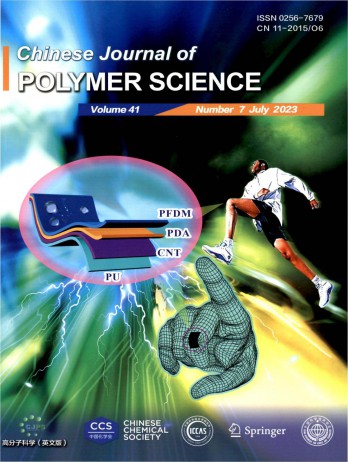Chinese Journal of Polymer Science雜志簡介
《Chinese Journal of Polyer Science》創刊于1983年,為月刊,由中國化學會;中國科學院化學研究所主辦。
《Chinese Journal of Polyer Science》主要出版發行分子層面的有面、無機、分析、物理化學、生物、高分子等領域高水平的研究綜述、論文、快報和簡報。
Chinese Journal of Polymer Science發文方向
Feature、Articles、Papers、Notes、Rapid、Communications
Chinese Journal of Polymer Science雜志特色
Instructions to Authors
Submission
Papers appearing in the Journal comprise Regular Articles, Notes, Rapid Communications, which should contain original information, theoretical or experimental, on any topics in the field of polymer science and polymer material science. Feature Articles are also welcome. Papers already published or scheduled to be published elsewhere will not be accepted.
Notes and Rapid Communications are limited to less than four pages of the Journal. Notes are concerned with subjects of limited scope, which require no further information in a future publication. Rapid Communications deal with significant findings worthy of urgent publication. Feature Articles are limited to review of the author's own results in a systematic research, which have been published recently, in part or in whole.
For papers submitted for publication as Rapid Communications, a brief introduction outlining the significance of the work and the rationale for urgent publication must be submitted together with the manuscript.
Manuscripts should be submitted via web-based online submission system
Manuscripts
Manuscripts should be written in English, double-spaced and single-sided on A4 sheets with margins of 3 cm all round, and should be numbered beginning with the title page. The first page of an article should contain only (1) the title of the paper, (2) the name(s) and address(es) of the author(s), (3) an abstract of 50-250 words, (4) 3-5 keywords and (5) an abbreviated title not exceeding 45 characters (including spaces) for the running head.
Heading and Subheadings for different sections of the paper should be clearly indicated.
Units of measurement, abbreviations and symbols should follow the International System of Units (SI). Equations and formulae should be typed clearly. Equations should be numbered consecutively with Arabic numerals in parentheses on the right-hand side of the page. Any special symbols should be identified in the margin.
Tables should be typed on separate sheets together with a suitable caption at the top of each table. All the tables should be numbered consecutively in Arabic numerals.
Figures should be submitted on separate sheets and numbered consecutively in Arabic numerals. All figure captions should be summarized on a separate sheet after the text. For best results, figures should be submitted at the actual size at which they should appear in the journal and fit a half column width(Max. 8.0 cm). A full column width (Max. 17 cm) will be considered only when absolutely necessary to the clarity of the figure. For figures, the minimum font size should be 8 pt and the minimum line width should be 0.4 pt. TIFF, EPS or JPG files are the preferred format. Suggested packages for line graphics are Origin (preferred, please use line width 2 and symbol size 12), Adobe Illustrator (version 3.0 or above), Freehand and Corel Draw. Files of scanned line graphics can be accepted preferably at a resolution of 1000dpi (Min. 600dpi). Black and white photos, micrographs etc should not be saved as color.
References should be cited in the text with Arabic numerals within square brackets in order of appearance, and listed at the end of the paper in numerical order. The following style should be followed for the reference list:
Journal:
Reference number, surname, initial(s), journal, year of publication, volume number: page number
1 Mochel, K.D., J. Polym. Sci., A-1, 1972, 10: 1009
2 Wang, H.L., Chen, J.M., Huang, Y. and Shen, J.R., Chinese J. Polym. Sci., 1997, 15(10): 57
3 Einaga, Y. and Fujita, H., Polymer, in press
Books:
Reference number, surname, initial(s), "title", edition, publisher, place of publication, year, page number
4 Zhou, Q.F. and Wang, X.J., "Liquid crystalline polymers" (in Chinese), Science Press, Beijing, 1994,
p.88
5 Schmidt, H., in “Hanbook of environmental chemistry, Vol. 2E”, ed. by Hutzinger, O., Springer, Berlin Heidelberg New York, 2003, p.111
Patents:
Reference number, inventor's surname, initial(s), or patentee (firm), year, patent number
6 Furukawa, J., Kobayashi, E. and Takahire, K., 1974, U.S.Pat., 3,817,968
Theses (PhD)
Reference number, surname, initial(s), “title”, thesis, university, (place of university), year
7 Trent, J.W., “Experimental acute renal failure”, Thesis, University of California, 1975
Graphical Abstract
All manuscripts must be accompanied by a graphical abstract which will be published in the Journal’s Table of Contents. The graphical abstract consists of a brief summary and a graphic highlighting the key findings of the work. Such summaries are limited to 50 words in length and should not be confused with the abstract. The graphic could be a key figure or scheme of the manuscript or a graphic specially prepared for Table of Contents. The graphic could be in the form of a structure, reaction/mechanism scheme, graphical data, photograph etc., but tables or spectra are not recommended. Color graphic is encouraged. The Graphical Abstract should be incorporated on the last page of the manuscript. The authors are asked to supply the materials in the following format:
Graphical Abstract
“Title of the manuscript”
Authors
Brief summary
Graphic
雜志收錄與榮譽
Chinese Journal of Polymer Science雜志數據統計注:由于版面限制,此處僅列出部分數據信息,了解詳情請聯系客服 了解詳情 >>
年度期刊評價報告 (本刊綜合數據對比及走勢)
名詞解釋:
影響因子:指該期刊近兩年文獻的平均被引用率,即該期刊前兩年論文在評價當年每篇論文被引用的平均次數
被引半衰期:衡量期刊老化速度快慢的一種指標,指某一期刊論文在某年被引用的全部次數中,較新的一半被引論文刊載的時間跨度
期刊他引率:他引率是指,此期刊被引用次數中,被其他刊引用次數所占的比例
引用半衰期:指某種期刊在某年中所引用的全部參考文獻中較新的一半是在最近多少年時段內刊載的
平均引文率:在給定的時間內,期刊篇均參考文獻量,用以測度期刊的平均引文水平,考察期刊吸收信息的能力以及科學交流程度的高低
雜志被引半衰期、引用半衰期
雜志影響因子、被引次數
雜志發文量、期刊他引率
雜志平均引文率
我們提供的服務
在線客服
一對一咨詢服務、簡單快捷、省時省力
了解更多 >快遞配送
直郵到家、實時跟蹤、更安全更省心
了解更多 >雜志訂閱
去除中間環節享受低價,物流進度實時通知
了解更多 >雜志推薦
正版雜志,匹配度高、性價比高、成功率高
了解更多 >期刊導航
常見問題
相關期刊
友情鏈接
免責聲明
若用戶需要出版服務,請聯系出版商,地址:北京市中關村一街2號化學所院內,郵編:100190。
